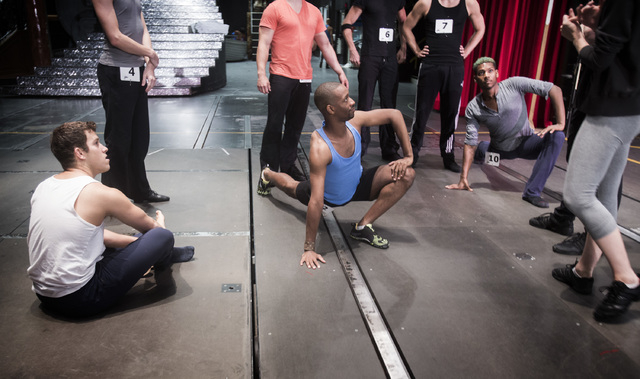10 men twirl and whirl to be in ‘Jubilee!’
With a No. 1 sign pinned to his black pants, John Marr steps forward on the stage of the Jubilee Theater as the music — Imagine Dragons’ “It’s Time” — blasts.
“Five, six, seven, eight,” male dance captain Bobbie Bannister says, signaling Marr to begin.
Across the stage, Marr spins into his double pirouette and lands. He does a double pirouette again and lands. Finally, he turns into yet another double pirouette, but this time he lands, faces three judges, gives a slight smile and walks off the stage.
The start to another round of auditions for “Jubilee!” has begun.
When thinking of “Jubilee!” the image of showgirls dressed with giant headdresses and bathed in jewels and rhinestones comes to mind.
“They are iconic. But behind every showgirl is a male dancer to support (her),” says Diane Palm, company manager for the show that opened at Bally’s in 1981.
It’s 10 a.m. on a Monday, and it’s time to see what male talent is out there at the next round of “Jubilee!” auditions, which take place about every six months.
“It can be tough for guys,” says Dane Reis, who is auditioning. “There aren’t a lot of opportunities, but then again there isn’t a big pool (of men) to choose from.”
Palm; Suzanne Swanson, assistant company manager for “Jubilee!”; and Gene Lubas, creative director, sit in front of the stage to judge the auditions.
Palm was once on the other side of the experience.
“I can’t tell you how many auditions I’ve been through,” she says. “I don’t miss those days.”
The three judges take notes, exchange comments and notice every detail in trying to determine who would be the best addition to the show.
“Have fun guys,” Palm says. “Don’t be nervous.”
After the 10 men, they have another 35 women to get to.
Palm says on audition day, they are looking for a few things.
“Obviously, they have to be a certain height,” she says. “We are looking for trained professionals, but we are also looking for someone who can bring something unique to the show.”
Aside from being 18 or older, guys must be at least 5 foot 10 inches and women must be at least 5 foot 8 inches.
They aren’t looking for a certain number of spots to fill, but more for creative talent who might fit the show.
One at a time, each guy steps up to a measuring stick and straightens his back as Colbert mashes a ruler down on his head confirming he meets the requirement.
Then a quick photo is snapped, and it’s on to the next one for his measurement.
The first part of the audition, each dancer is tested on some basic individual techniques.
Bannister and Kathy Colbert, the female dance captain, take the 10 hopefuls through various choreography, some of which is in the show.
In about 10 minutes, the group must learn a contemporary routine. Colbert and Bannister break down the dance into parts, going over eight steps at a time.
Then dancers have two opportunities to showcase their talents.
“We will have them do it twice,” Palm says. “Once for them to get the nerves out.”
The group is broken into two groups of three and a group of four.
After a few moments to grab a swig of water and rush back to the stage, the next dance — disco — is even longer.
“So can we see the guys with their shirts off?” Palm says.
Stripping off their shirts, some dancers drop down to do a few pushups before returning to the stage for the next round of critiques. This time, they perform in front of the judges in groups of five.
Walking off the stage after the audition, Reis plops down in one of the theater chairs and takes a giant swallow of water.
The sweat from the nearly two-hour audition is seeping through his red shirt.
“I felt I had a good audition,” he says, wiping his face.
Dancing in “Jubilee!” has been in his mind since he started dancing in high school in Montana after a football injury caused him to give up the sport.
“I had an instructor who used to dance in the show,” he says. “She would show us these amazing photos.”
After graduating from the University of Montana, he traveled as a dancer working in Boston, New York and Australia.
He and his wife moved to Las Vegas where she got a part in “Jubilee!”
Previously, he has worked around town at shows such as “Dancing Queen.” But this is his first time back auditioning in a while.
The last routine was the most exhausting for Reis.
“This was the longest lull I’ve had between jobs,” he says. “I’m still working to get my cardio back.”
A few rows behind Reis, Marr sits cooling off after dancing two hours.
He moved to Las Vegas three weeks ago after working for several years on Carnival Cruise Lines in hopes of being a dancer in a show on the Strip.
“This is my third audition in town,” he says.
A few days earlier, he was going through similar rigorous routines for “Legends in Concert” and “Vegas! the Show.”
Each comes with its own challenge.
For each audition, Marr says he has ended up as either the first or second dancer to perform, adding to his nerves.
“It has its pros and cons,” he says.
This time around being the first made him nervous — he says the double pirouette isn’t his strongest move, he says.
Although able to showcase any move the choreographer throws out, the judges want someone who is having a good time while doing it.
While the guys finish up their dances, 35 women stretched in the aisles of the theater as they waited for their turn.
“It will be something similar,” Bannister says.
At the end of the auditions, all 10 form a straight line in front of the judges.
Three guys are cut on the spot and the others are invited to callbacks at a later time.
About six years ago, it was Bannister who was in the same shoes auditioning for a coveted spot.
“So I am really sympathetic to what they’re going through,” he says.
As a dancer, Bannister knows what these guys are up against.
“This can be a very hard city for boys,” he says. “However, there is a smaller pool of us to choose from compared to the ocean of females to choose from.”
Even to those who are cut, he always encourages them to come back for the next round of auditions.
“I was cut my first time around,” he says. “I made it all the way to callbacks. There were about 12 of us and they only chose one guy.”
He knew he would audition again, and six months later he was back in front of a panel of three judges ready for a second chance.
“This time, they chose four guys,” Bannister says. “And I was one of them.”
Contact reporter Michael Lyle at mlyle@reviewjournal.com or 702-387-5201. Find him on Twitter: @mjlyle.


































